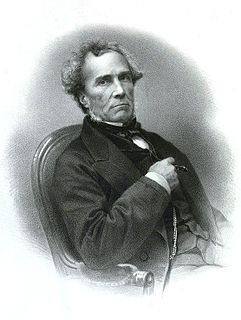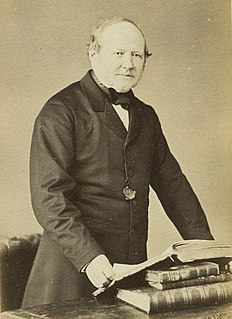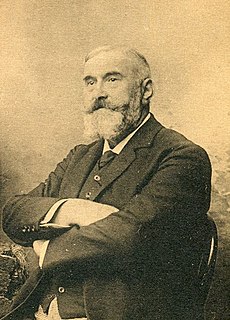
Guillaume-Chrétien de Lamoignon de Malesherbes, often referred to as Malesherbes or Lamoignon-Malesherbes, was a French statesman and minister in the Ancien Régime, and later counsel for the defense of Louis XVI. He is known for his vigorous criticism of royal abuses as President of the Cour des Aides and his role, as director of censorship, in helping with the publication of the Encyclopédie. Despite his committed monarchism, his writings contributed to the development of liberalism during the French Age of Enlightenment.

Alexis Charles Henri Clérel, comte de Tocqueville, colloquially known as Tocqueville, was a French aristocrat, diplomat, political scientist, political philosopher and historian. He is best known for his works Democracy in America and The Old Regime and the Revolution (1856). In both, he analyzed the living standards and social conditions of individuals as well as their relationship to the market and state in Western societies. Democracy in America was published after Tocqueville's travels in the United States and is today considered an early work of sociology and political science.

De La Démocratie en Amérique is a classic French text by Alexis de Tocqueville. Its title literally translates to On Democracy in America, but official English translations are usually simply entitled Democracy in America. In the book, Tocqueville examines the democratic revolution that he believed had been occurring over the previous several hundred years.

Adolphe Charles Adam was a French composer, teacher and music critic. A prolific composer for the theatre, he is best known today for his ballets Giselle (1841) and Le corsaire (1856), his operas Le postillon de Lonjumeau (1836) and Si j'étais roi (1852) and his Christmas carol "Minuit, chrétiens!".

Horace François Bastien Sébastiani de La Porta was a French general, diplomat, and politician, who served as Naval Minister, Minister of Foreign Affairs, and Minister of State under the July Monarchy.

François-Louis Nompar de Caumont Laporte, comte de Castelnau was a French naturalist, known also as François Laporte or Francis de Castelnau. The standard author abbreviation Castelnau is used to indicate him when citing a botanical name and zoological names other than insects. Laporte is typically used when citing an insect name, or Laporte de Castelnau.

Comte Gustave Auguste Bonnin de la Bonninière de Beaumont was a French magistrate, prison reformer, and travel companion to the famed philosopher and politician Alexis de Tocqueville. While he was very successful in his lifetime, he is often overlooked and his name is synonymous with Tocqueville's achievements.
The Pineton de Chambrun is a French aristocratic family, of which several members have taken an important part in French politics. Their nobility was proven in 1491. The Pineton de Chambrun originally come from the Gévaudan region, where many members were mayors or deputies of Lozère.

Alexis-François Artaud De Montor was a diplomat and historian. An émigré during the French Revolution, he was entrusted by the royal princes with missions to the Holy See and served during the campaign of Champagne in the Army of Condé. Napoleon Bonaparte made him secretary of the French Legation in Rome. Artaud occupied this post under François Cacault, left Rome for a short time when Cardinal Joseph Fesch, Cacault's successor, brought Chateaubriand with him, and returned to Rome in the same capacity after Chateaubriand had resigned. Appointed chargé d'affaires of France to Florence in 1805 he was recalled in 1807 because he was wrongfully suspected of having employed his power on behalf of the Queen of Etruria, whose possessions Napoleon wished to give to Elisa Bonaparte.

The Constitution of 1848 is the constitution passed in France on 4 November 1848 by the National Assembly, the constituent body of the Second French Republic. It was repealed on 14 January 1852 by the constitution of 1852 which profoundly changed the face of the Second Republic and served as the basis for the Second French Empire.

Fleury François Richard, sometimes called Fleury-Richard, was a French painter of the École de Lyon. A student of Jacques-Louis David, Fleury-Richard and his friend Pierre Révoil were precursors of the Troubador style.

Marie Adrienne Françoise de Noailles, Marquise de La Fayette, was a French marchioness. She was the daughter of Jean de Noailles and Henriette Anne Louise d'Aguesseau, and married Gilbert du Motier, Marquis de Lafayette.

The House of La Fayette was a French family of Nobles of the Sword, from the province of Auvergne, established during the Middle-Age by the lords of the fief of La Fayette held by the senior branch of the Motier family.

Cristina Trivulzio di Belgiojoso was an Italian noblewoman, the princess of Belgiojoso, who played a prominent part in Italy's struggle for independence. She is also notable as a writer and journalist.

Léonard-Alexis Autié, also Autier, often referred to simply as Monsieur Léonard, was the favourite hairdresser of Queen Marie Antoinette and in 1788–1789 founded the Théâtre de Monsieur, "the first resident theatre in France to produce a year-round repertory of Italian opera."

Victor Ambroise Lanjuinais was a French politician. He was a deputy from 1838 to 1848, and minister of Agriculture and Commerce in the second cabinet of Odilon Barrot.
Baron Auguste Jean Marie de Schonen was a French lawyer and politician. He was a deputy in the National Assembly, and played a leading role in the July Revolution of 1830. Later he became more conservative and was made a peer of France by King Louis Philippe.
Calmann-Lévy is a French publishing house founded in 1836 by Michel Lévy as Michel Lévy frères. His brother Kalmus Calmann Lévy joined in 1844, and the firm was renamed Calmann Lévy in 1875 after Michel's death.

Georges Vicaire was a French bibliophile and bibliographer. The son of Henri Vicaire (1802-1865), General Director of forests, and Marthe Vicaire Blais, Georges Vicaire was the father of Jean Vicaire and Marcel Vicaire (1893–1976), an orientalist painter.
Léon-Jean-Joseph Dubois (1780-1846) was a French illustrator and lithographer, also an archaeologist and curator at the Louvre museum.
















